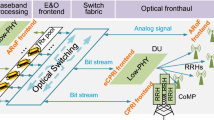Abstract
The cloud radio access network (C-RAN) is composed of optical networks and is known to a fronthaul network. In the fronthaul network, remote radio heads (RRHs) connect to a baseband processing unit (BBU) and BBUs connect to the BBU pool in the 5G core network. Multimedia traffic in radio is transmitted to the core network through the fronthaul network. Although the fronthaul is an optical network, bandwidth of the fronthaul is insufficient for mobile multimedia services because mobile multimedia services are based on large amounts of data. Therefore, it is necessary to control the bandwidth usage in the fronthaul. In 5G mobile networks, RRHs can use a mobile edge computing (MEC) server as an edge cloud and can perform complicated operations in the MEC using knowledge of fronthaul. The proposed method controls incoming traffic to the fronthaul network using knowledge according to the network condition in the fronthaul. When the bandwidth of the fronthaul becomes full due to a large amount of traffic, incoming traffic to the fronthaul network is controlled. The MEC server acts as a buffer for incoming multimedia traffic. Through the proposed method, transmission efficiency for massive multimedia traffic in the fronthaul can be improved. The performance is validated through computer simulation.











Similar content being viewed by others
References
Afrin M, Razzaque MA, Anjum I, Hassan MM, Alamri A (2017) Tradeoff between User Quality-Of-Experience and Service Provider Profit in 5G Cloud Radio Access Network. Sustainability 9(11):ID 2127
Checko A, Avramova AP, Berger MS, Christiansen HL (2016) Evaluating C-RAN fronthaul functional splits in terms of network level energy and cost saving. J Commun Netw 18(2):162–172
Cisco (2016) Cisco Visual Networking Index: Global Mobile Data Traffic Forecast, 2015–2020, Cisco 2016
Cisco (2017) Cisco Visual Networking Index: Global Mobile Data Traffic Forecast Update, 2016–2021, Cisco 2017
Feng L, Zhou F, Yu P, Li W (2018) Benders decomposition-based video bandwidth allocation in mobile media cloud network. Multimed Tools Appl 77(1):877–895
Frank H, Fuhrmann W, Ghita B (2016) Mobile Edge Computing: Requirements for Powerful Mobile near Real-Time Applications, In Proc. of the 11th International Network Conference (INC), Frankfurt, Germany
Hailu DH, Gebrehaweria BG, Kebede SH, Lema GG, Tesfamariam GT (2018) Mobile fronthaul transport option in C-RAN and emerging research directions: a comprehensive study. Opt Switch Netw 30:40–52
Hu YC, Patel M, Sabella D, Sprecher N, Young V (2015) Mobile Computing – A Key Technology towards 5G, ETSI White Paper, No. 11
International Telecommunication Union (ITU) (2015) IMT Vision—Framework and Overall Objectives of the Future Development of IMT for 2020 and Beyond M Series Mobile, Radiodetermination, Amateur and Related Satellite Services, International Telecommunication Union (ITU), Geneva, Switzerland
Jin Y, Qian Z, Sun G (2019) A real-time multimedia streaming transmission control mechanism based on edge cloud computing and opportunistic approximation optimization. Multimed Tools Appl 78(7):8911–8926
Kim DY, Kim S (2018) Traffic management considering fronthaul network conditions in 5G mobile networks, In Proc. of the 10th International Conference on Internet (ICONI), Phnom Penh, Cambodia
Kim DY, Kim S, Park JH (2017) A Combined Network Control Approach for the Edge Cloud and LPWAN-based IoT Services. Concurr Comput: Pract Exper:e4406. https://doi.org/10.1002/cpe.4406
Kim DY, Kim S, Park JH (2018) Traffic Management in the Mobile Edge Cloud to improve the quality of experience of Mobile video. Comput Commun 118:40–49
MacDougall MH (1987) Simulating computer systems: techniques and tool. The MIT Press, Cambridge
Mach P, Becvar Z (2017) Mobile edge computing: a survey on architecture and computation offloading. IEEE Commun Surv Tutor 19(3):1628–1656
Mao Y, You C, Zhang J, Huang K, Letaief KB (2017) A survey on Mobile edge computing: the communication perspective. IEEE Commun Surv Tutor 19(4):2322–2358
Palau CE, Mares J, Molina B, Esteve M (2011) Wireless CDN video streaming architecture for IPTV. Multimed Tools Appl 53(3):591–613
Ross SM (2001) Probability models for computer science. Harcourt/Academic Press, Orlando
Tran TX, Hajisami A, Pandey P, Pompili D (2017) Collaborative Mobile edge computing in 5G networks: new paradigms, scenarios, and challenges. IEEE Commun Mag 55(4):54–61
Trivedi KS (2002) Probability and statistics with reliability, queuing, and computer science applications. Wiley, Chichester
Wang S, Urgaonkar R, Zafer M, He T, Chan K, Leung KK (2015) Dynamic service migration in Mobile edge-clouds,” In Proc. of IFIP Networking
Yu H, Lee H, Jeon H (2017) What is 5G? Emerging 5G Mobile Services and Network Requirements. Sustainability 9(10):ID 1848
Zhang W, Wen Y, Chen HH (2014) Toward transcoding as a service: energy-efficient offloading policy for green Mobile cloud. IEEE Netw 28(6):67–73
Zhang K, Mao Y, Leng S, Zhao Q, Li L, Peng X, Pan L, Maharjan S, Zhang Y (2016) Energy-efficient offloading for Mobile edge computing in 5G heterogeneous networks. IEEE Access 4:5896–5907
Zikria YB, Kim SW, Afzal MK, Wang H, Rehmani MH (2018) 5G Mobile Services and Scenarios: Challenges and Solutions. Sustainability 10(10):ID 3626
Acknowledgements
This research was supported by Basic Science Research Program through the National Research Foundation of Korea(NRF) funded by the Ministry of Education(NRF-2017R1D1A1B03032777), and this work was supported by the Soonchunhyang University Research Fund.
Author information
Authors and Affiliations
Corresponding author
Additional information
Publisher’s note
Springer Nature remains neutral with regard to jurisdictional claims in published maps and institutional affiliations.
Rights and permissions
About this article
Cite this article
Kim, DY., Kim, S. Incoming Traffic Control of Fronthaul in 5G Mobile Network for Massive Multimedia Services. Multimed Tools Appl 80, 34443–34458 (2021). https://doi.org/10.1007/s11042-020-08793-x
Received:
Revised:
Accepted:
Published:
Issue Date:
DOI: https://doi.org/10.1007/s11042-020-08793-x




